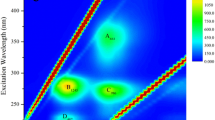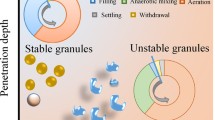Abstract
A hydraulic retention time (HRT) of 4, 6, and 8 h was employed, respectively, in three reactors to study the effects of HRT on granulation with a newly developed fast granulation strategy, i.e., a strategy by combining strong hydraulic selection pressure with high organic loading rate (OLR). Granules with clear boundary appeared within 24 h after reactor start-up and all reactors reached a pseudo steady state after 6-day operation. A 4-h HRT resulted in a relatively higher increasing rate in terms of granule size during granule development period, i.e., 208 μm day−1, and the bigger granule size and the higher sludge volume index at the pseudo steady state. For HRT of 6 or 8 h, no obvious difference was observed. However, it was found that HRT influenced sludge retention time (SRT) and kinetics significantly. A HRT changing from 4 to 8 h led to an increased SRT from 3 to 21 days, a decreased observed specific biomass growth rate (μ obs) and an decreased observed biomass yield (Y obs) of stable granules from 0.37 to 0.062 days−1, and 0.177 to 0.055 g MLVSS g−1 COD, respectively. Both μ obs and Y obs had a linear relationship with the reciprocal of HRT. In addition, the great difference of microbial community between seed sludge, sludge retained in the reactors, and sludge washed out indicated a strong microbial selection for fast granulation within 24 h. However, during the granule development period from day 1 to 6, no more microbial selection was observed except an adjustment of microbial community. Little influence of HRT on microbial population in granular sludge indicated a minor role of HRT played for granulation with the fast start-up strategy adopted in this study. The results demonstrated that hydraulic selection pressure for granulation was mainly from short settling time, which led to strong microbial selection during the granulation period. Meanwhile, although HRT did not affect granulation with the fast start-up strategy, it played an important role on sludge retention time and excess sludge production. Therefore, HRT should be carefully optimized to balance benefits and shortfalls it brings to aerobic granular sludge system.







Similar content being viewed by others
References
Adav SS, Lee DJ, Show KY, Tay JH (2008) Aerobic granular sludge: recent advances. Biotechnol Adv 26:411–423
Amann RI, Ludwig W, Schleifer KH (1995) Phylogenetic identification and in situ detection of individual microbial cells without cultivation. Microbiol Mol Biol Rev 59:143–169
APHA (1998) Standard methods for the examination of water and wastewater, 20th edn. American Public Health Association, Washington
Beun JJ, Hendriks A, van Loosdrecht MCM, Morgenroth E, Wilderer PA, Heijnen JJ (1999) Aerobic granulation in a sequencing batch reactor. Water Res 33:2283–2290
Chen FY, Liu YQ, Tay JH, Ning P (2015) Rapid formation of nitrifying granules treating high-strength ammonium wastewater in a sequencing batch reactor. Appl Microbiol Biotechnol 99:4445–4452
Clarke KR, Warwick RM (1994) Change in marine communities: an approach to statistical analysis and interpretation. Natural Environmental Research Council, Plymouth
Egert M, Friedrich MW (2003) Formation of pseudo-terminal restriction fragments, a PCR-related bias affecting terminal restriction fragment length polymorphism analysis of microbial community structure. Appl Environ Microbiol 69:2555–2562
Ivanov V, Wang XH, Tay STL, Tay JH (2006) Bioaugmentation and enhanced formation of microbial granules used in aerobic wastewater treatment. Appl Microbiol Biotechnol 70:374–381
Kong Q, Ngo HH, Shu L, Fu RS, Jiang CH, Miao MS (2014) Enhancement of aerobic granulation by zero-valent iron in sequencing batch airlift reactor. J Hazard Mater 279:511–517
Li AJ, Li XY, Yu HQ (2011) Granular activated carbon for aerobic sludge granulation in a bioreactor with a low-strength wastewater influent. Sep Purif Technol 80:276–283
Liu Y, Tay JH (2004) State of the art of biogranulation technology for wastewater treatment. Biotechnol Adv 22:533–563
Liu YQ, Tay JH (2007a) Influence of cycle time on kinetic behaviors of steady-state aerobic granules in sequencing batch reactors. Enzyme Microb Technol 41:516–522
Liu YQ, Tay JH (2007b) Characteristics and stability of aerobic granules cultivated with different starvation time. Appl Microbiol Biotechnol 75:205–210
Liu YQ, Tay JH (2007c) Cultivation of aerobic granules in a bubble column and an airlift reactor with divided draft tubes at low aeration rate. Biochem Eng J 34:1–7
Liu YQ, Tay JH (2012) The competition between flocculent sludge and aerobic granules during the long-term operation period of granular sludge sequencing batch reactor. Environ Technol 33:2919–2926
Liu YQ, Tay JH (2015) Fast formation of aerobic granules by combining strong hydraulic selection pressure with overstressed organic loading rate. Water Res 80:256–266
Liu YQ, Moy B, Kong Y, Tay JH (2010) Formation, physical characteristics and microbial community structure of aerobic granules in a pilot-scale sequencing batch reactor for real wastewater treatment. Enzyme Microb Technol 46:520–525
Liu YQ, Kong YH, Tay JH, Zhu JR (2011) Enhancement of start-up of pilot-scale granular SBR fed with real wastewater. Sep Puri Technol 82:190–196
Lv Y, Wan C, Lee DJ, Liu X, Tay JH (2014) Microbial communities of aerobic granules: granulation mechanism. Bioresour Technol 169:344–351
Morgenroth E, Sherdeni T, Van MCM, Heijnen JJ, Wilderer PA (1997) Aerobic granular sludge in a sequencing batch reactor. Water Res 31:3191–3194
Pan S, Tay JH, He YX, Tay STL (2004) The effect of hydraulic retention time on the stability of aerobically grown microbial granules. Lett Appl Microbiol 38:158–163
Qin L, Tay JH, Liu Y (2004) Selection pressure is a driving force of aerobic granulation in sequencing batch reactors. Process Biochem 39:579–584
Rosman NH, Anuar AN, Chelliapan S, Din MFM, Ujang Z (2014) Characteristics and performance of aerobic granular sludge treating rubber wastewater at different hydraulic retention time. Bioresour Technol 161:155–161
Su KZ, Yu HQ (2005) Formation and characterization of aerobic granules in a sequencing batch reactor treating soybean-processing wastewater. Environ Sci Technol 39:2818–2827
Toh KS, Tay JH, Moy BYP, Ivanov V, Tay STL (2003) Size-effect on the physical characteristics of the aerobic granule in a SBR. Appl Microbiol Biotechnol 60:687–695
Tijhuis L, van Loosdrecht MCM, Heijnen JJ (1994) Formation and growth of heterotrophic aerobic biofilms on small suspended particles in airlift reactors. Biotechnol Bioeng 44:595–608
Verawaty M, Pijuan M, Yuan Z, Bond PL (2012) Determining the mechanisms for aerobic granulation from mixed seed of floccular and crushed granules in activated sludge wastewater treatment. Water Res 46:761–771
Wang ZW, Liu Y, Tay JH (2006) The role of SBR mixed liquor volume exchange ratio in aerobic granulation. Chemosphere 62:767–771
Weissbrodr DG, Lochmatter S, Ebrahimi S, Rossi P, Maillard J, Holliger C (2012) Bacterial selection during the formation of early-stage aerobic granules in wastewater treatment systems operated under wash-out dynamics. Front Microbiol 3:332–354
Wijffels RH, Tramper J (1995) Nitrification by immobilized cells. Enzyme Microb Technol 17:482–492
Wu SY, Hung CH, Lin CN, Chen HW, Lee AS, Chang JS (2006) Fermentative hydrogen production and bacterial community structure in high-rate anaerobic bioreactors containing silicone-immobilized and self-flocculated sludge. Biotechnol Bioeng 93:934–946
Yang YC, Liu X, Wan C, Sun S, Lee DJ (2014) Accelerated aerobic granulation using alternating feed loadings: alginate-like exopolysaccharides. Bioresour Technol 171:360–366
Zhang X, Liu YQ, Tay JH, Jiang WJ (2013) Fast granulation under extreme selection pressures and its formation mechanism. Fersenius Environ Bull 22:1330–1338
Zhou D, Niu S, Xiong Y, Yang Y, Dong S (2014) Microbial selection pressure is not a prerequisite for granulation: Dynamic granulation and microbial community study in a complete mixing bioreactor. Bioresour Technol 161:102–108
Compliance with ethical standards
This article does not contain any studies with human participants or animals performed by any of the authors.
Conflict of interest
All authors of this article declare that they have no conflict of interest.
Author information
Authors and Affiliations
Corresponding author
Rights and permissions
About this article
Cite this article
Liu, YQ., Zhang, X., Zhang, R. et al. Effects of hydraulic retention time on aerobic granulation and granule growth kinetics at steady state with a fast start-up strategy. Appl Microbiol Biotechnol 100, 469–477 (2016). https://doi.org/10.1007/s00253-015-6993-3
Received:
Revised:
Accepted:
Published:
Issue Date:
DOI: https://doi.org/10.1007/s00253-015-6993-3




